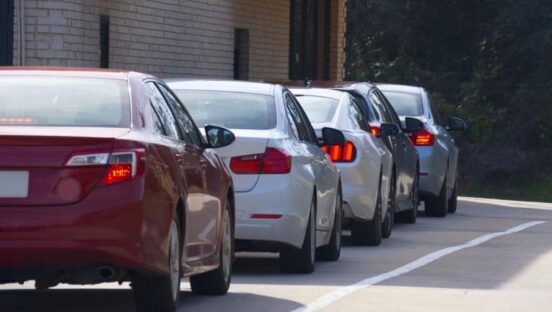It is believed that the first drive-thru was introduced by the Exchange National Bank of Chicago in 1930. The service allowed customers to conduct their banking transactions from their vehicles—a novel concept at the time. However, drive-thrus really took off in the fast-food industry during the 1950s and 1960s, when fast-food chains started adopting the drive-thru window to address the increasing reliance on cars. By the 1990s, drive-thrus became a standard feature at most quick-service restaurants, as they could serve more customers efficiently and reduce dine-in congestion.
In recent years, the growth and evolution of drive-thrus has mostly stagnated. Some restaurants have successfully integrated digital tools, such as order kiosks and mobile order-ahead capabilities, to the experience, but the general infrastructure remains the same. While the concept hasn’t seen significant changes it remains an integral part of the dining experience. According to the National Restaurant Association, 39 percent of all restaurant traffic is bumper to bumper in a drive-thru lane and restaurants are seeing 16 percent fewer people dining on-premises compared to before the pandemic.
For most quick-service restaurants, the drive-thru window is still at the heart of the operation, but drive-thru windows were not designed to facilitate online food ordering or third-party delivery, let alone the historic volume of traffic. To keep up with the times and prepare for the next chapter of quick-service restaurant customer experiences, restaurants must explore a new drive-thru model that reimagines what service looks like. Industry leaders should consider the following when evaluating the future of drive-thru operations.
Changing Consumer Behavior
The state of play that emerged out of the pandemic was one where customers prefer more efficient to-go offerings over dine-in options. According to the 2022 QSR Drive-Thru Report, more than a third (38 percent) of consumers found mobile ordering for drive-thru very appealing—a percentage that would be inconceivable ten years earlier. With an unprecedented surge in traffic, a massive shift towards online ordering, and an escalating demand for delivery services, restaurants had to quickly adapt their drive-thru operations.
Prior to the coronavirus pandemic, there was little need to drastically change the drive-thru experience. The proliferation of online food delivery platforms in the 2010s added an interesting wrinkle to the mix, but it was something most restaurants could accommodate through ad hoc measures. The pandemic, however, proved to be a powerful accelerant of this trend, directly challenging the traditional drive-thru model.
Outdated Design
Quick-serves were forced to tweak their drive-thru model to maintain business operations during the pandemic. Many restaurants introduced dedicated waiting spots to relieve the drive-thru queue. A staff member or two were responsible for rushing orders through the front door of the restaurant—they can’t exactly crawl out the drive-thru window—and hand-delivering to cars that had been waiting. Some opted to divide their drive-thru service so that food-delivery drivers had their own, separate process to pick up orders. As a result, other space on the restaurant property became relevant to the drive-thru and to-go experience.
While these changes helped improve the overall operation, they also reduced the effectiveness and benefit of the traditional drive-thru window. In many instances, windows actually became a barrier to service. The drive-thru window was not flexible enough to seamlessly service these evolving needs.
Updating the Drive-Thru Window
Breakdowns in the drive-thru experience can occur for a variety of reasons, including staffing shortages and poor technology integration. Forward-thinking quick-service restaurant leaders are realizing, however, that drive-thru inefficiencies are ultimately due to a design flaw, as a drive-thru services can no longer rely on one window to be the nexus of the operation. Fortunately, there is drive-thru design innovations available that can help the drive-thru model evolve, such as an automatic, sliding window and door hybrid.
This hybrid, hands-free technology allows restaurant staff to easily switch between an automatic door and automatic window mode without delay or interruption to customer service. Staff can opt for automatic door mode during times of heightened traffic, when dedicated waiting spots are filled up and the drive-thru queue is getting longer. During lull periods, staff can effortlessly swap back to the window, introducing flexibility to the drive-thru model.
The fast-food industry has witnessed numerous challenges in recent years. Aging technology, especially at the window, and staffing shortages have become a significant roadblock to seamless operations. With the ever-increasing demand for quick service and convenient food options, drive-thru efficiency and speed of service have emerged as crucial factors in maintaining customer satisfaction and profitability. Quick-service brands can do more with less by implementing new infrastructure and technology to improve throughput with quicker exchanges and reduced wait times. Updating the drive-thru window with a door-window hybrid solution will not only optimize service but completely redefine the drive-thru experience.
Greg Erickson, National Account Manager at STANLEY Access Technologies is responsible for bringing new, innovative products to the quick-service restaurant market. With 25-plus years’ experience in the automatic door industry, Greg has a proven track record developing and maintaining partnerships with some of the biggest names in retail, healthcare, and quick-service restaurants across the US and Canada. He has a deep understanding of the quick-service restaurant industry, new trends, challenges, and the future of drive-thru design solutions.








